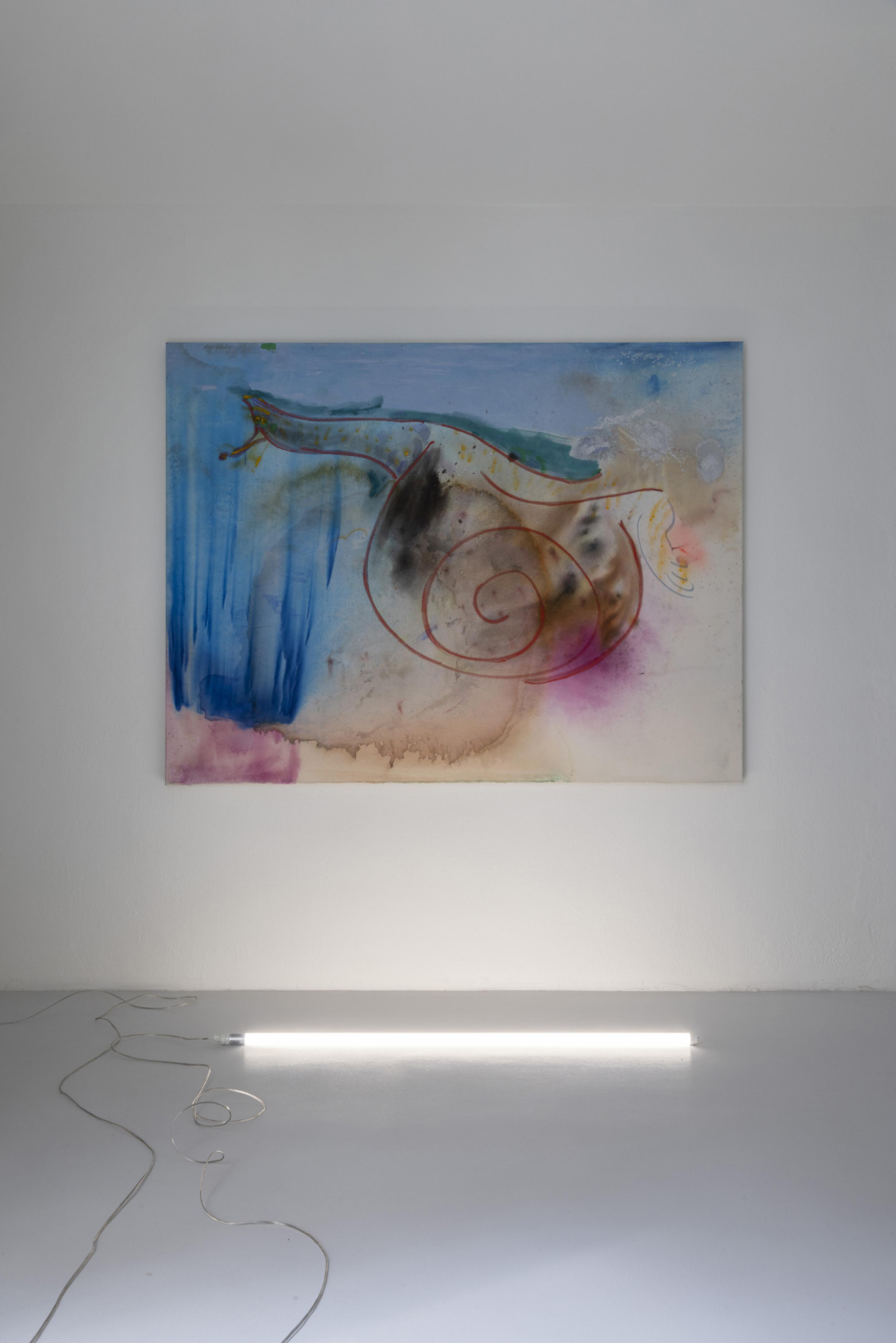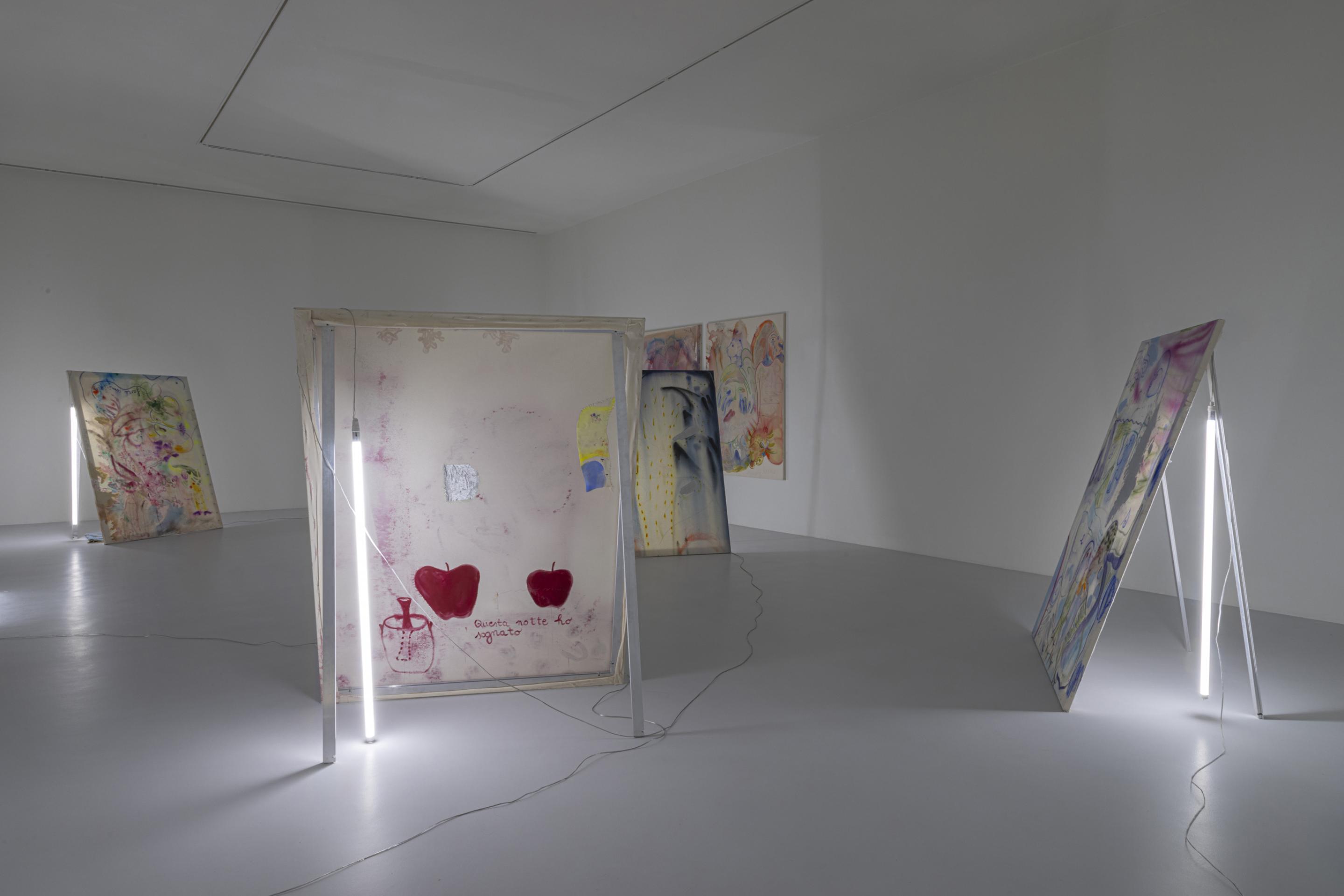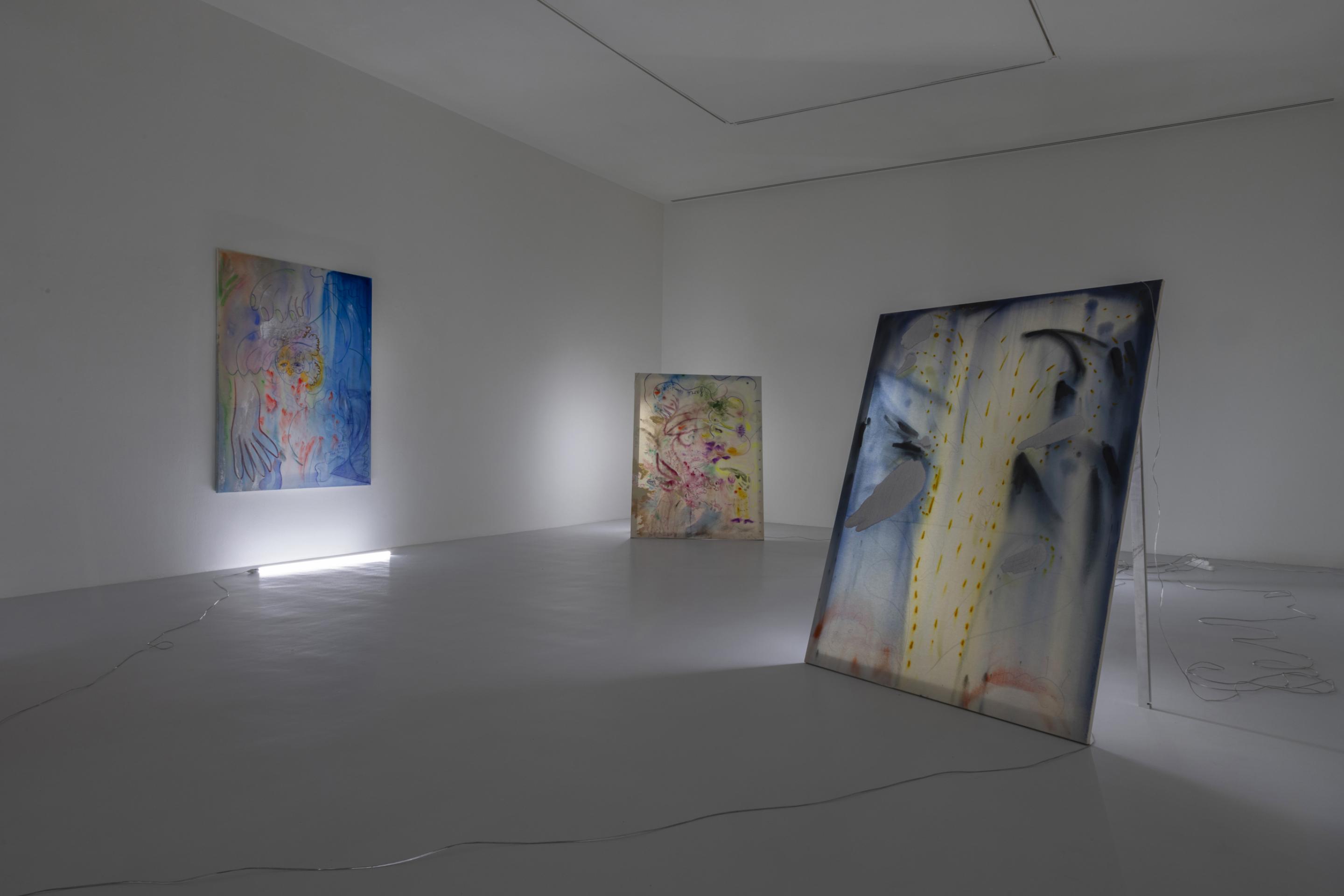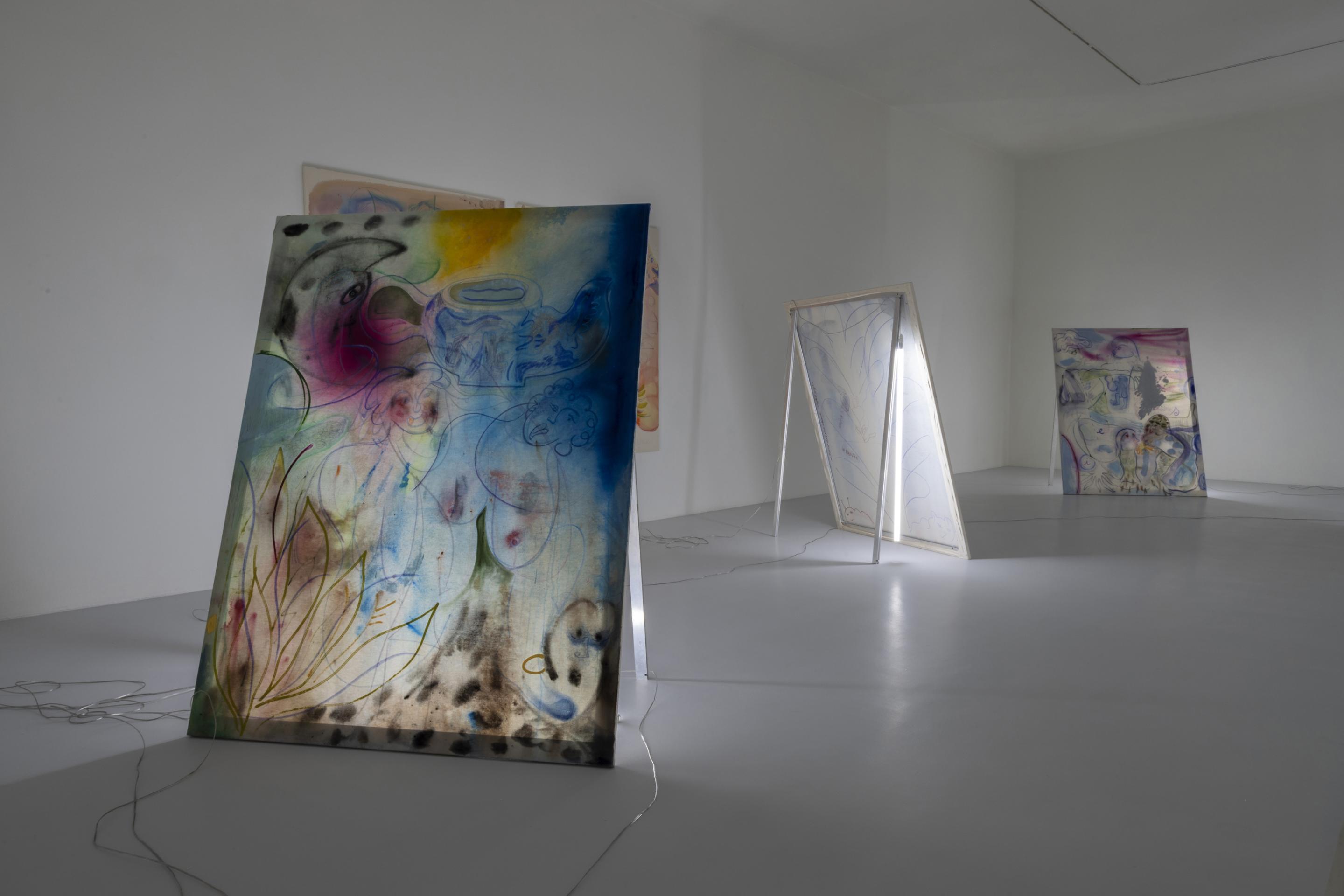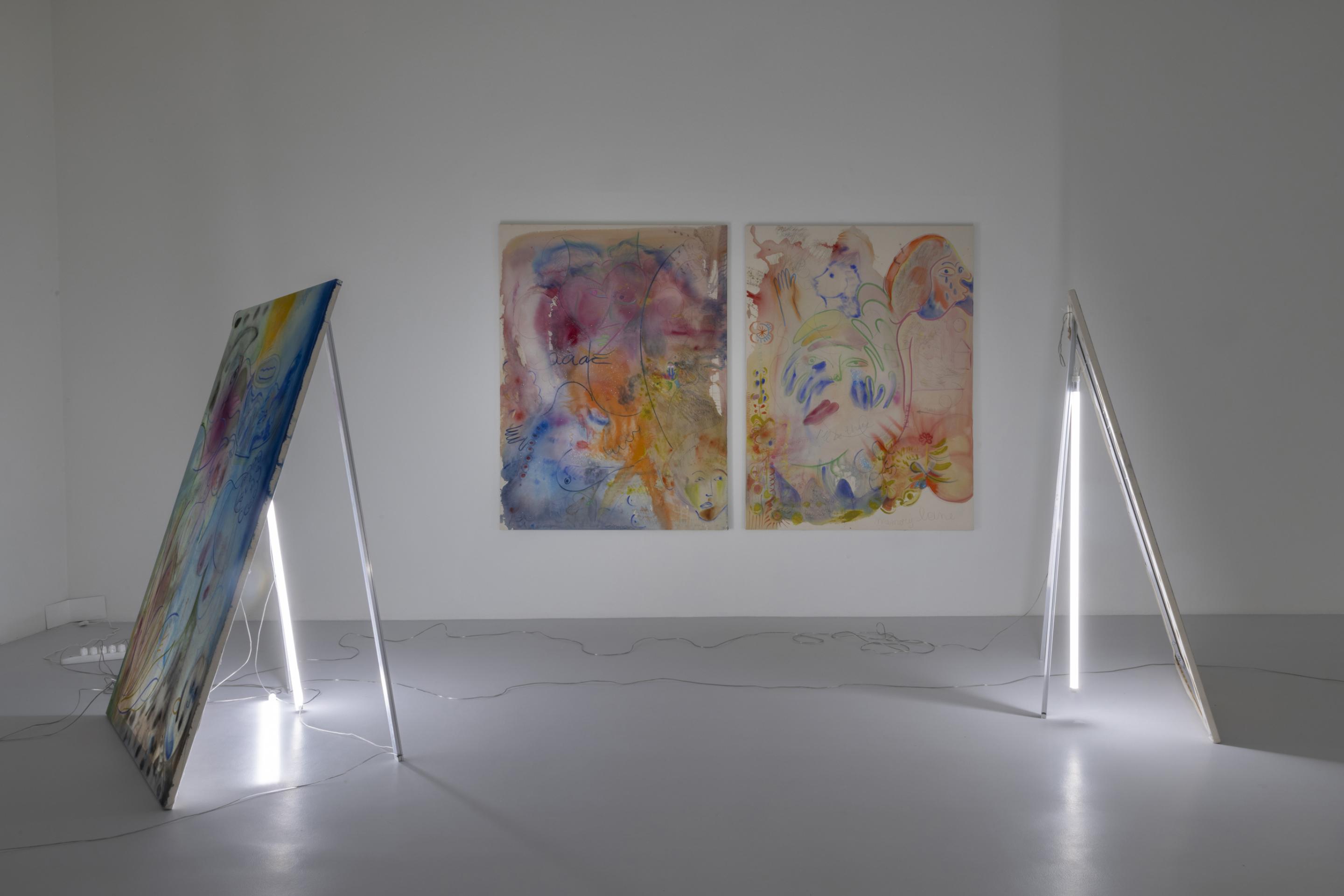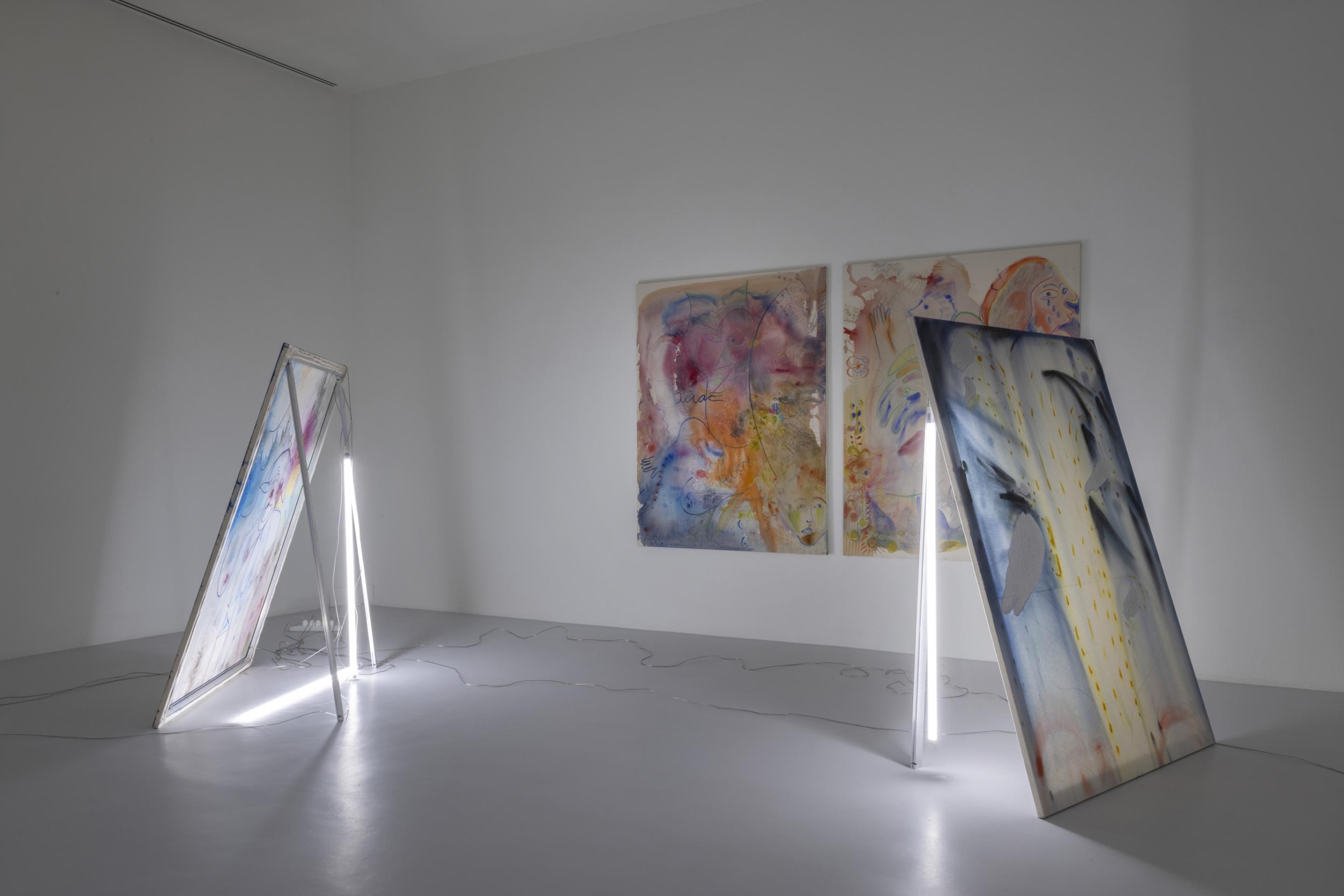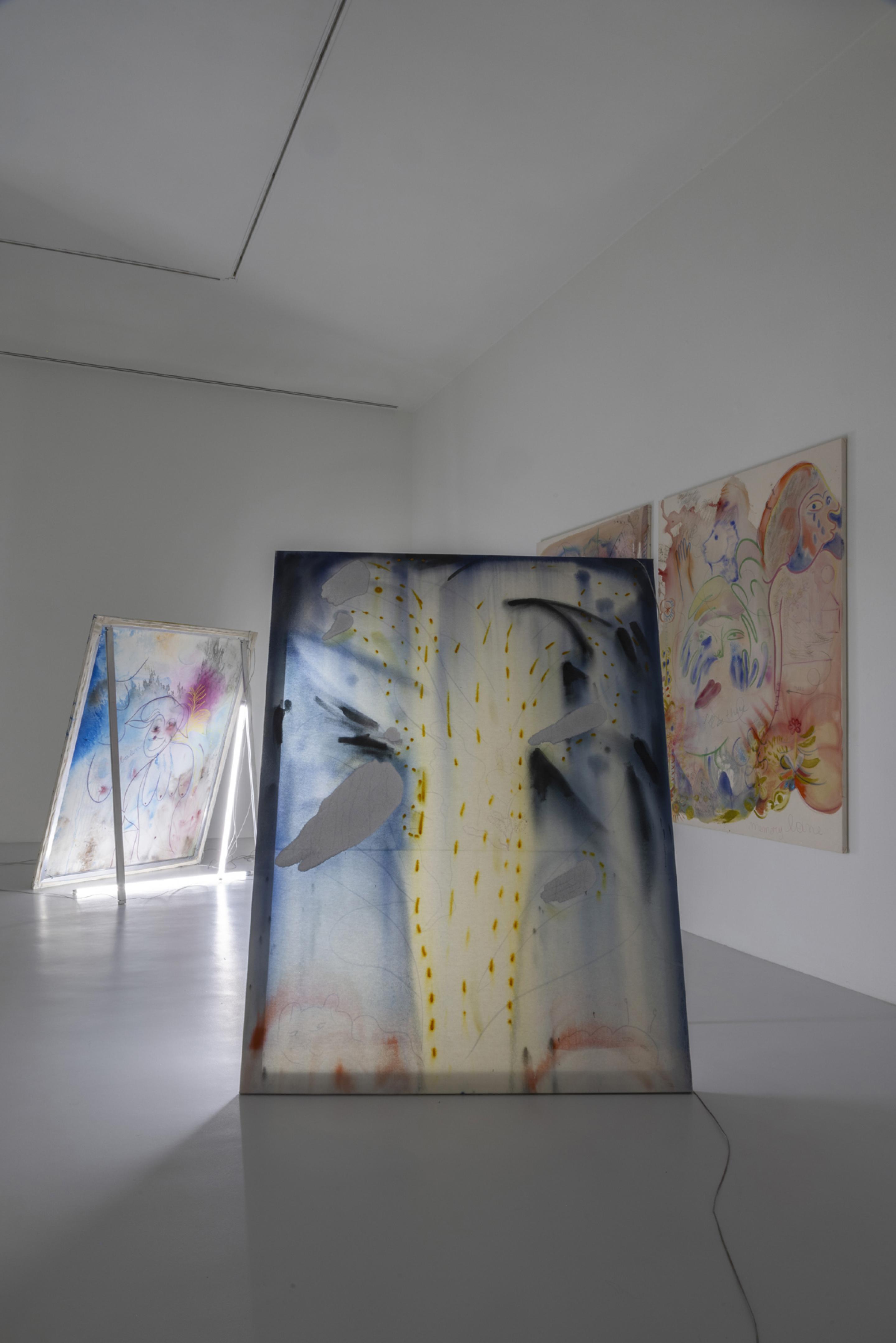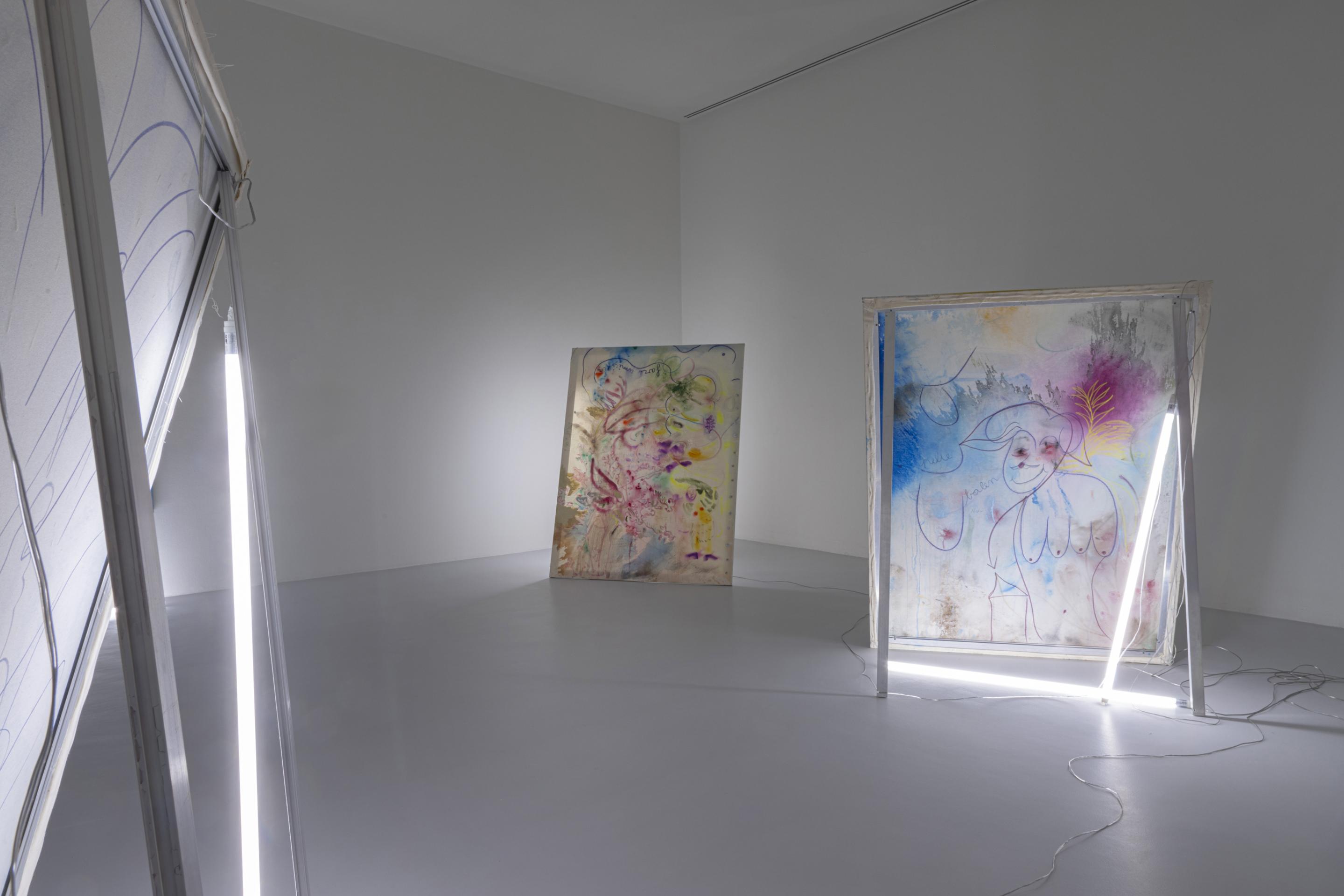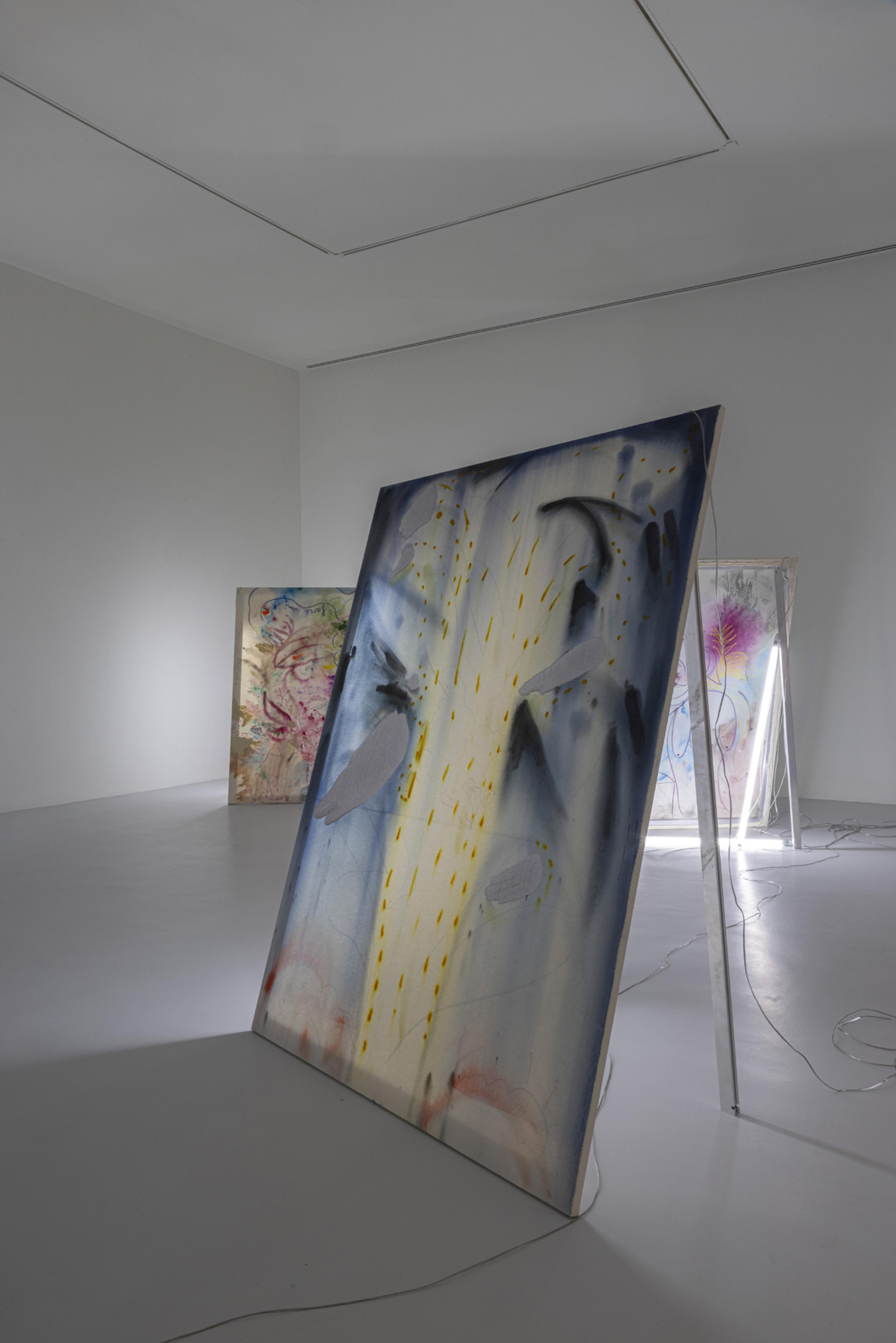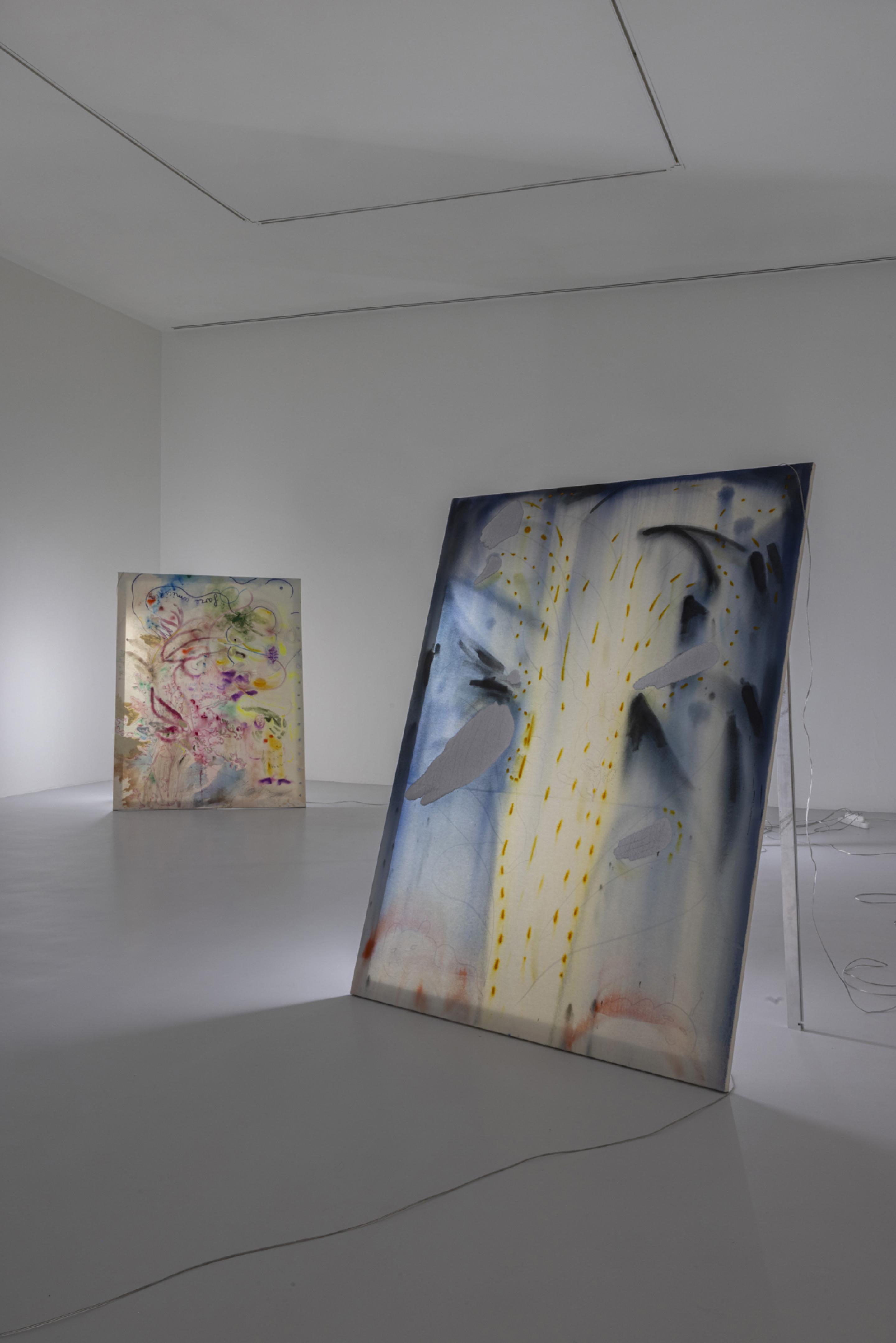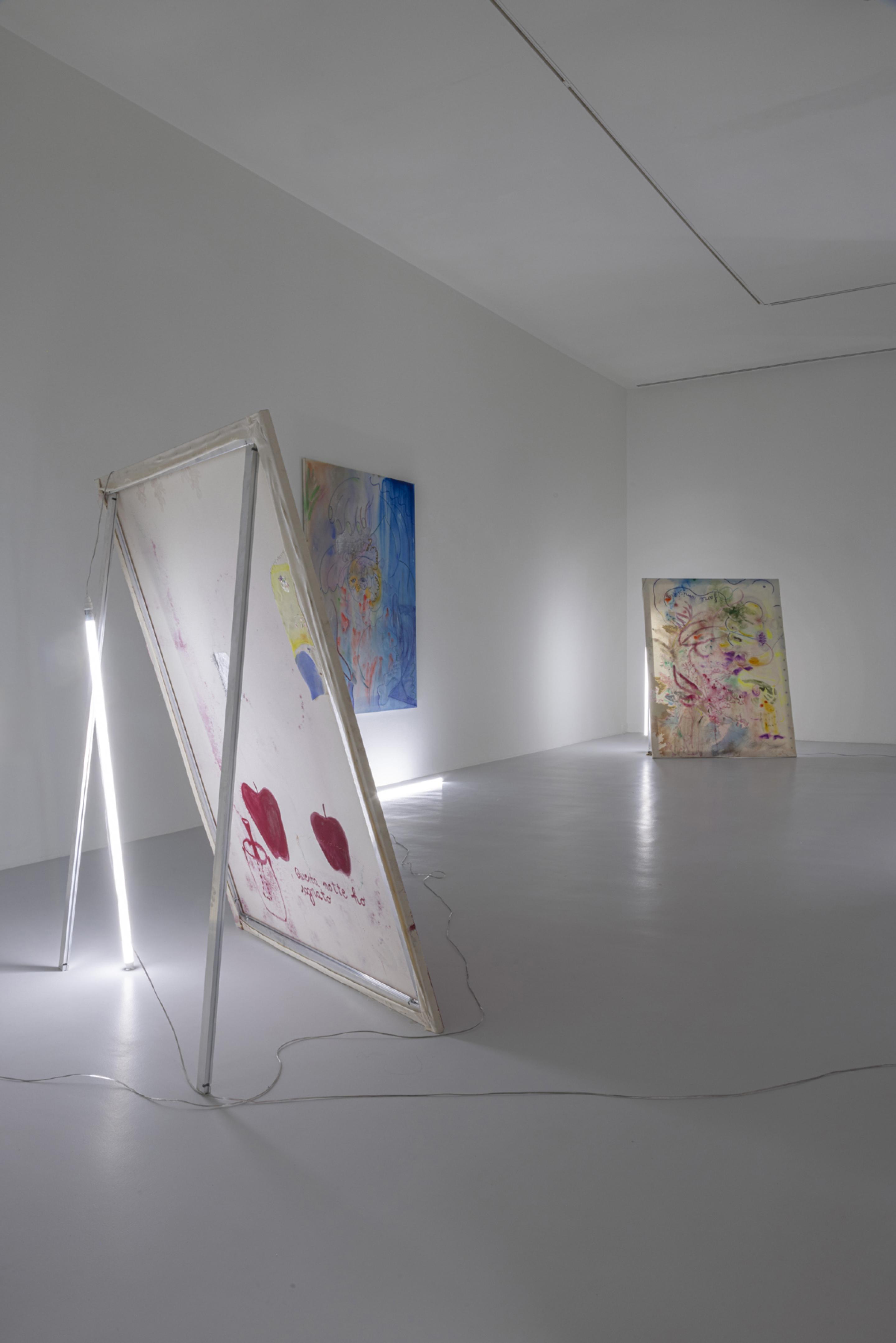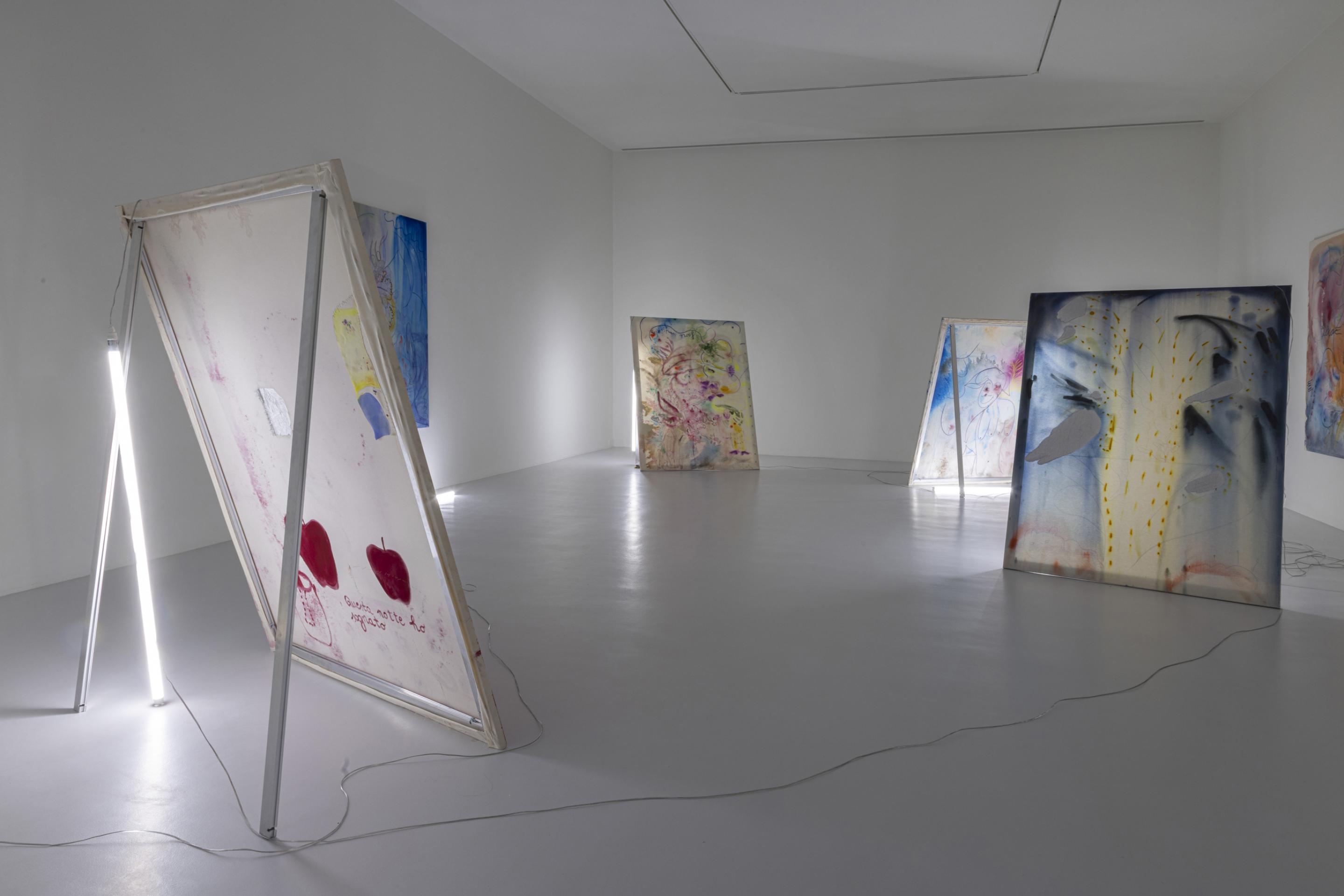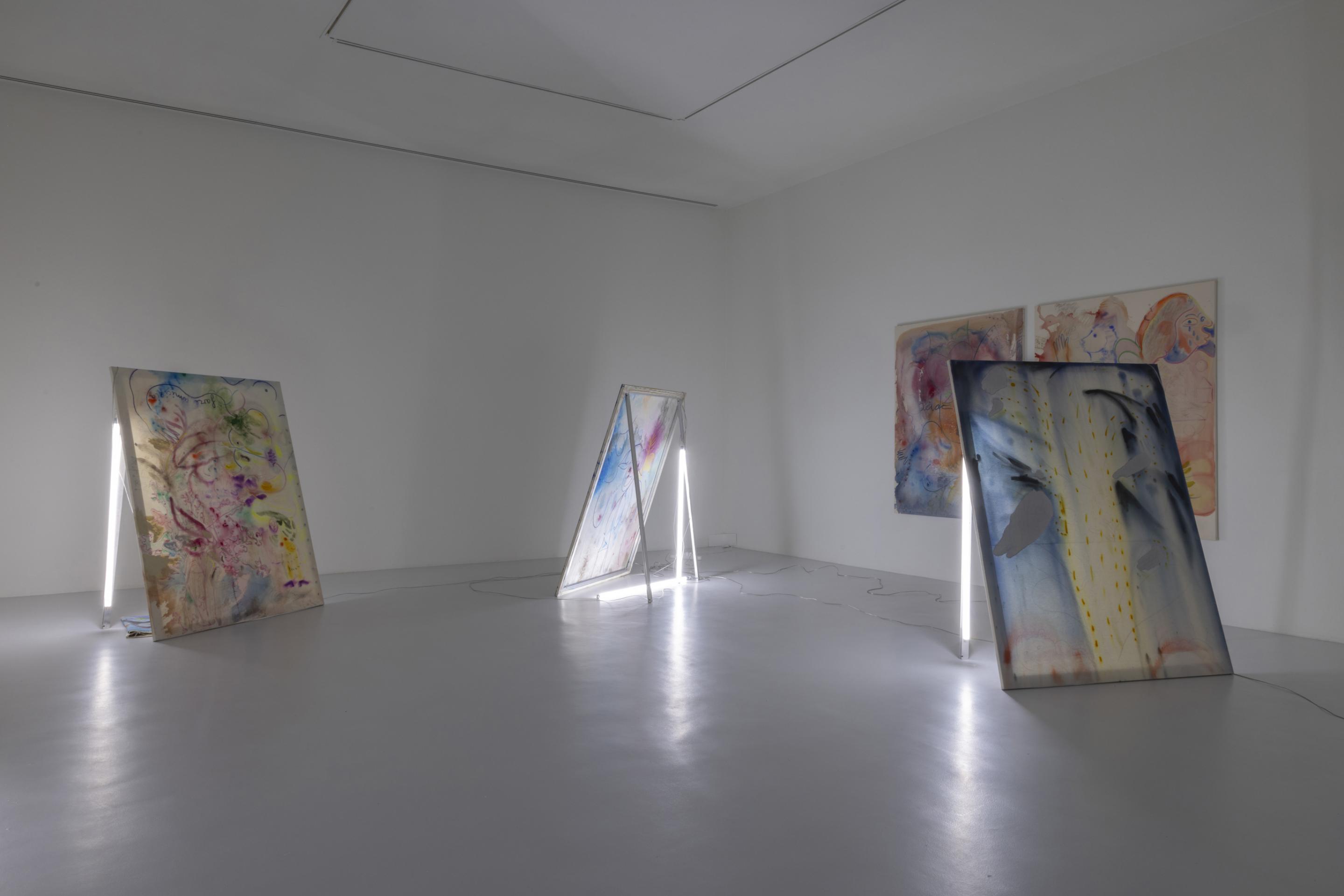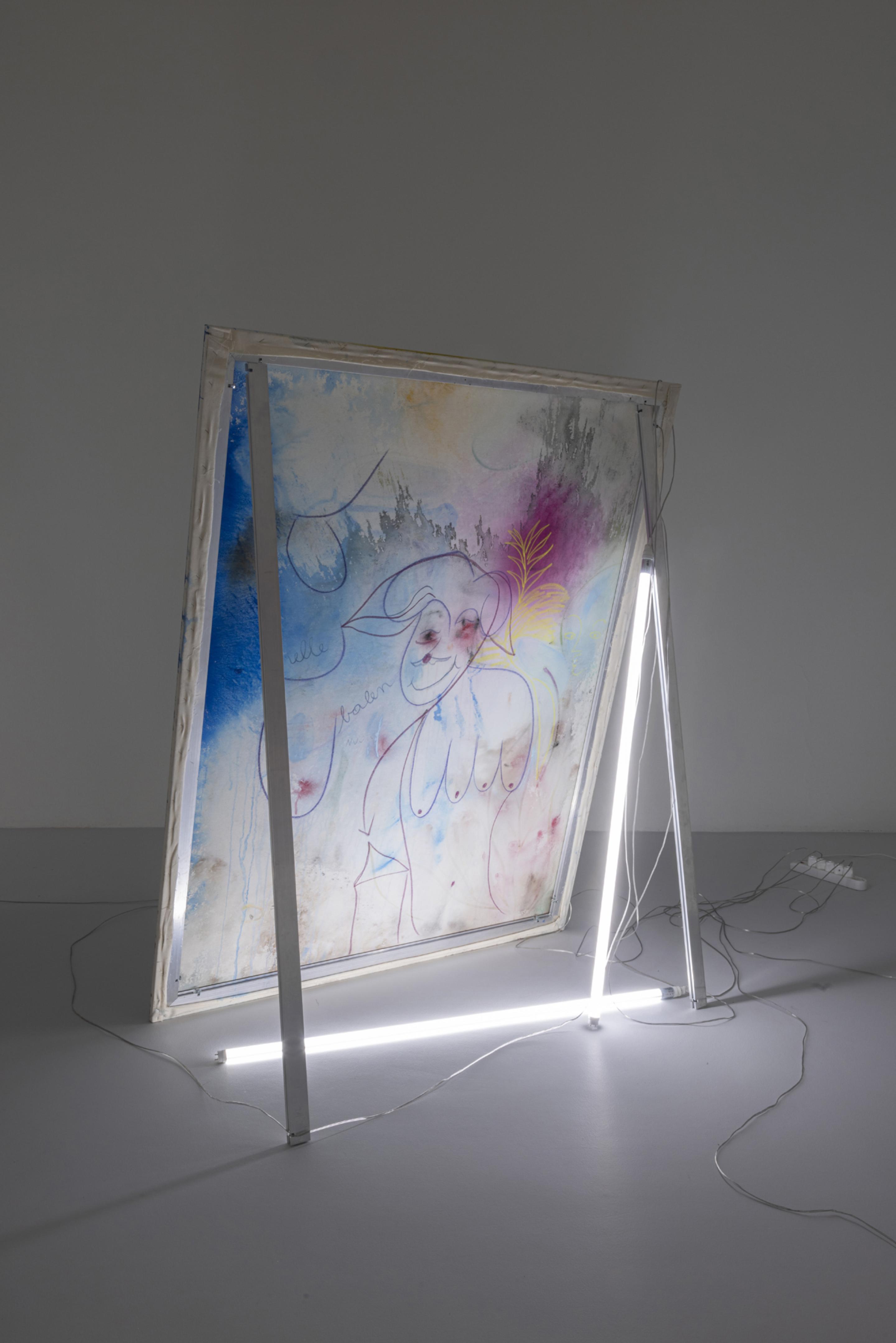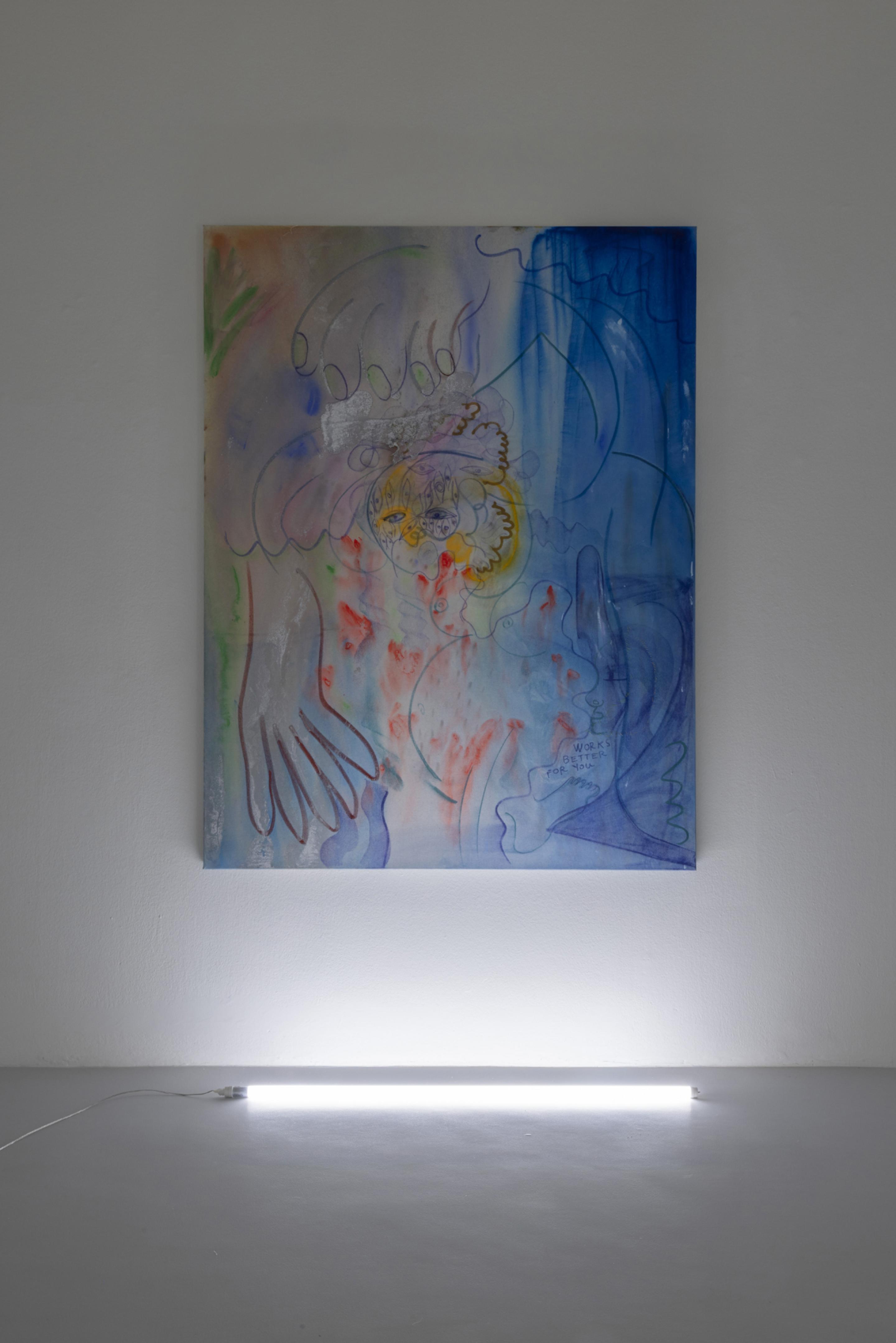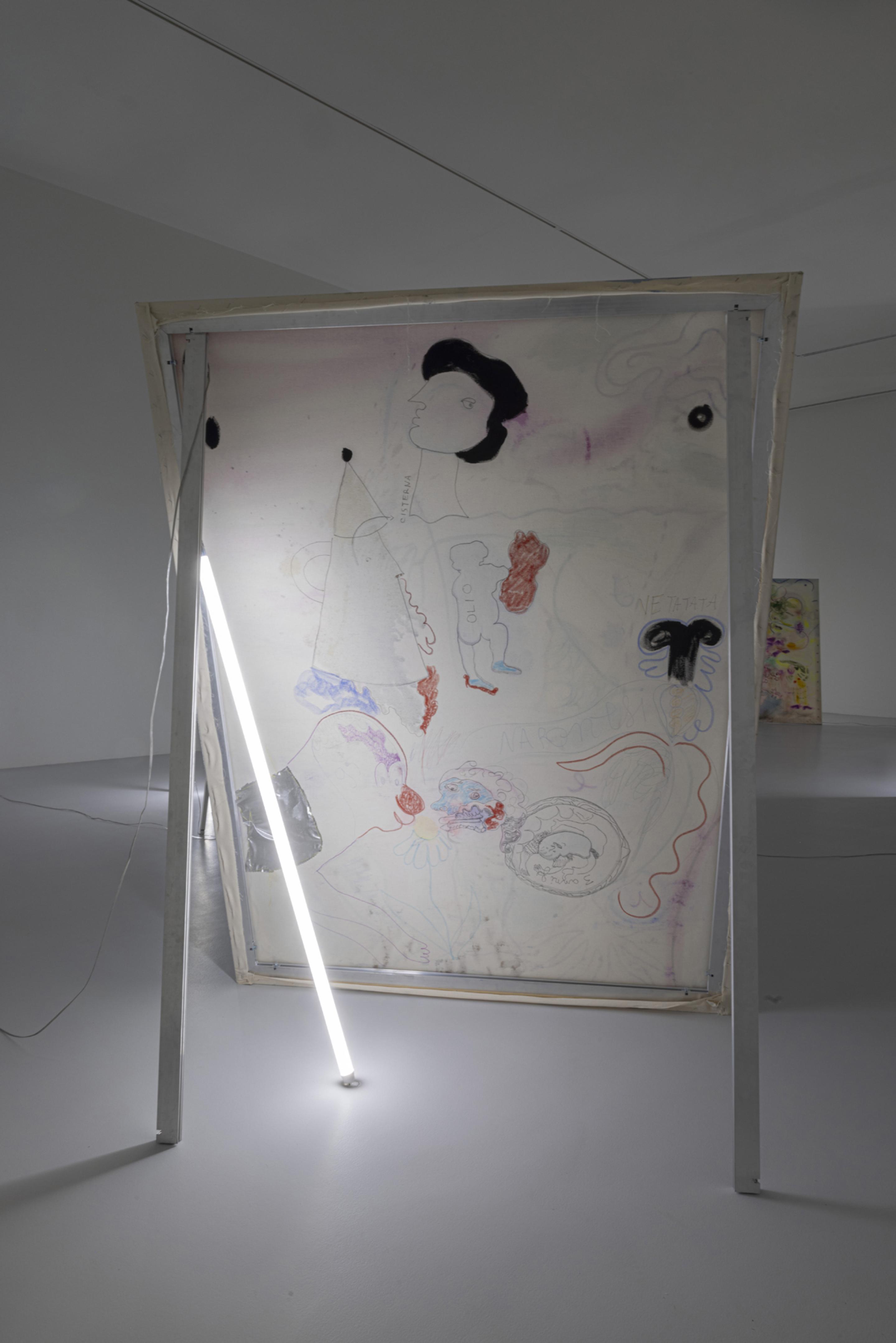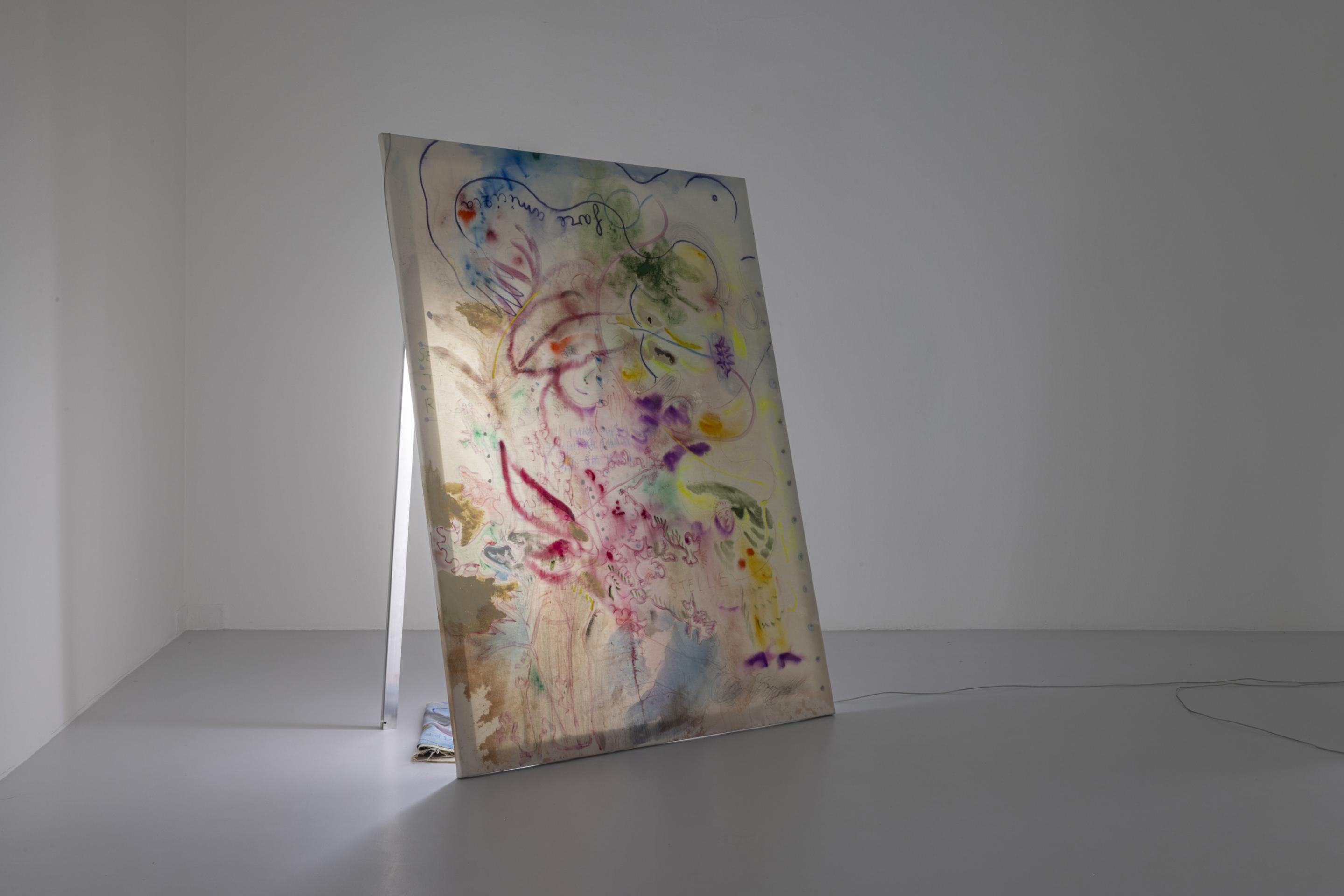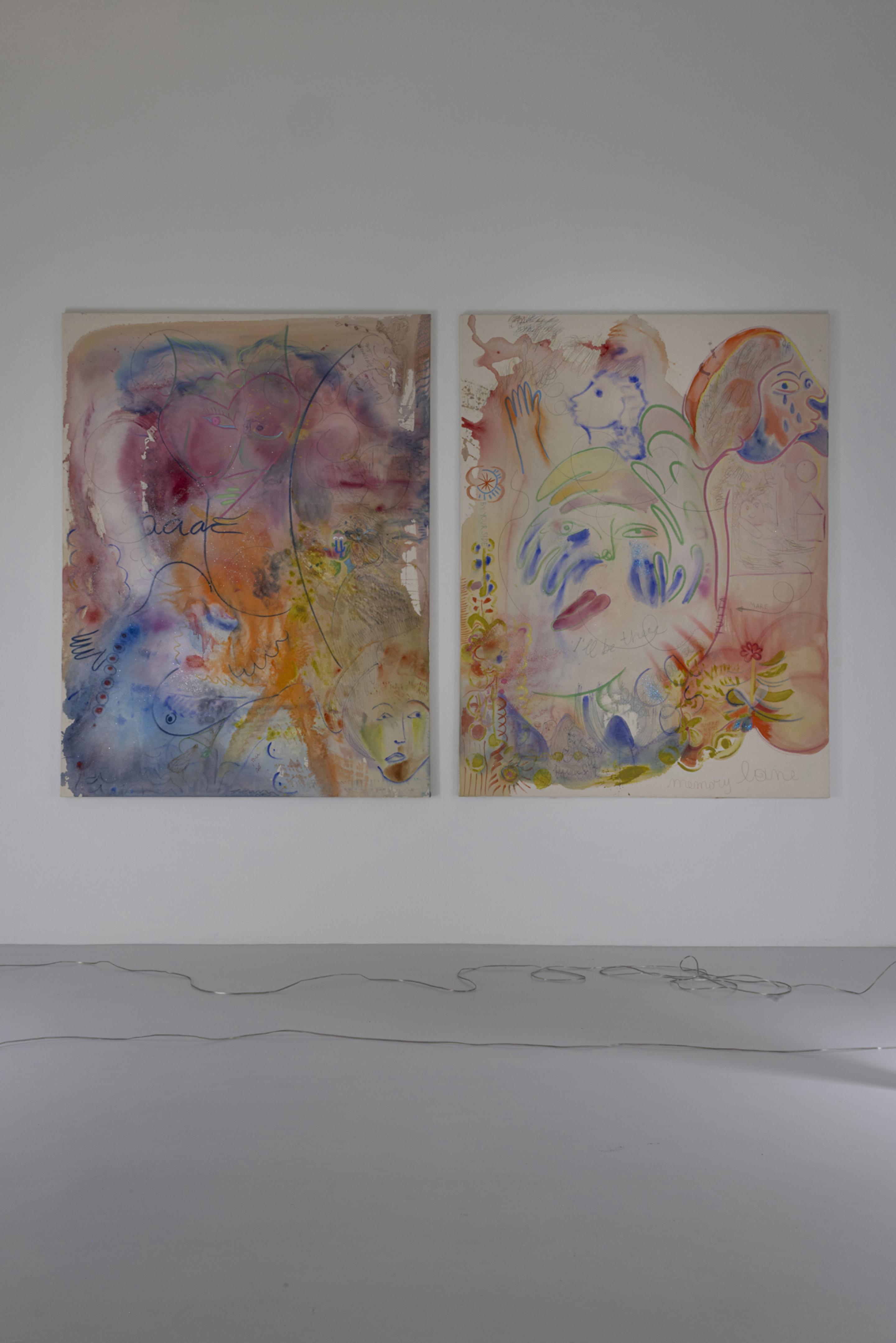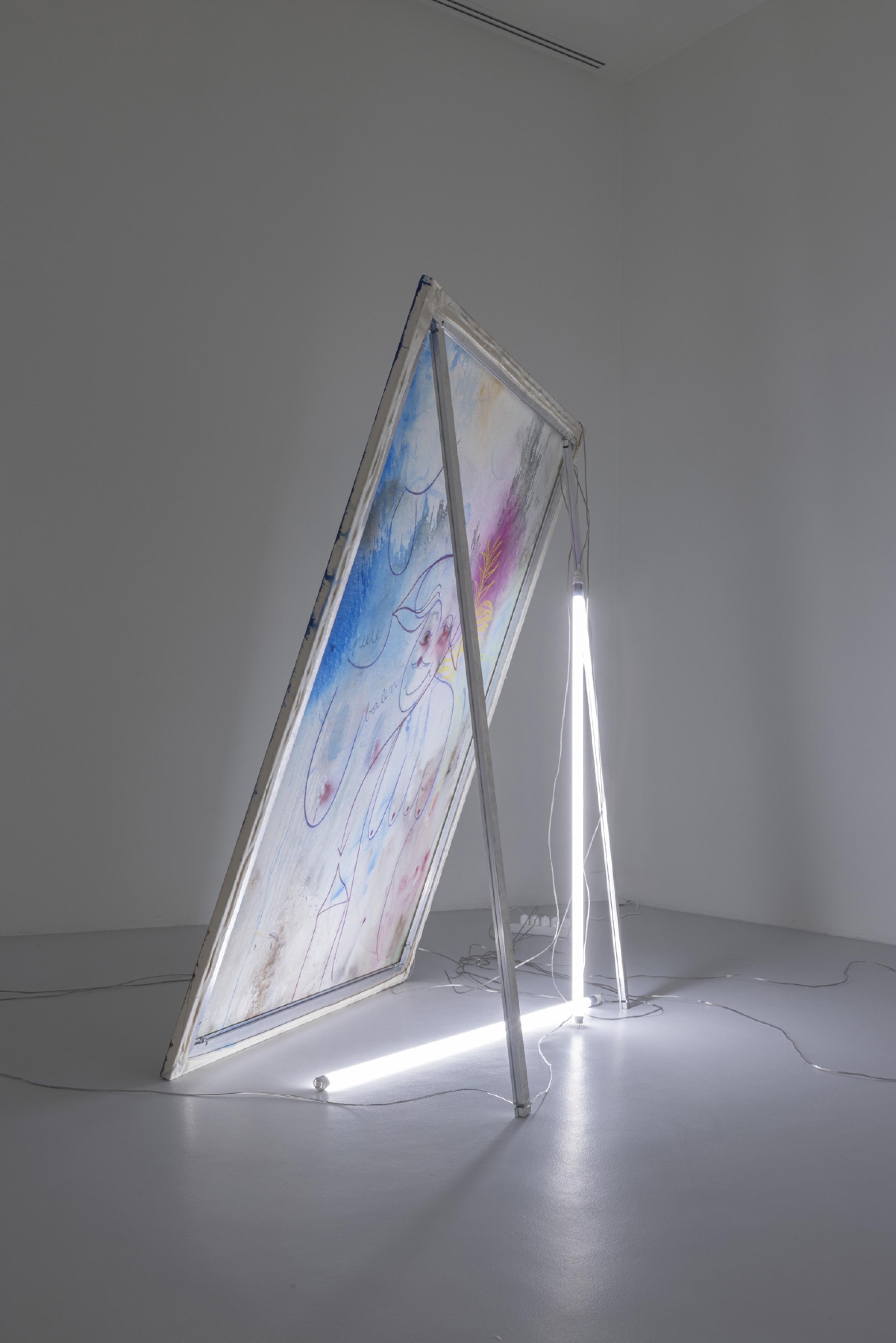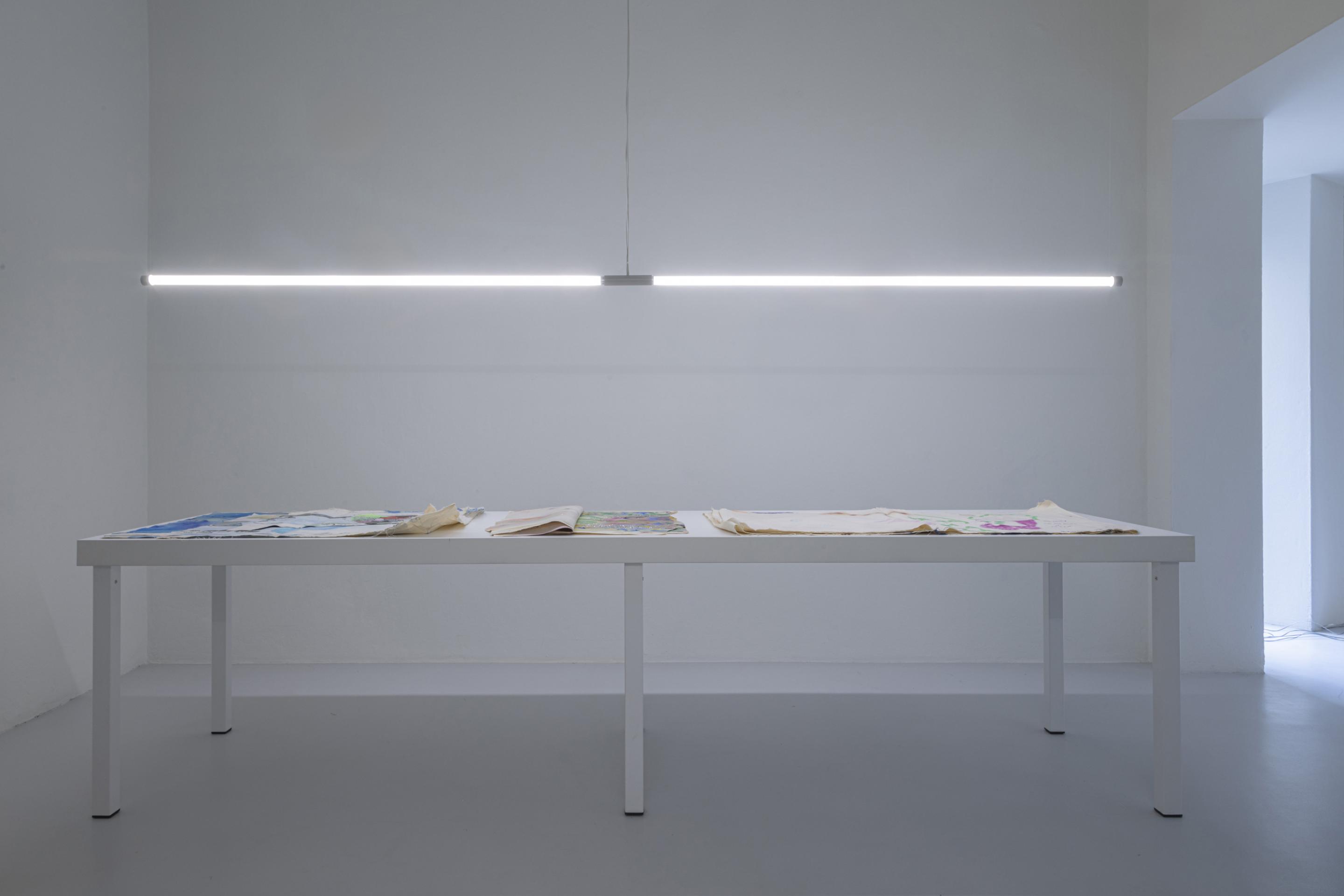AliceVISENTIN
Everyday Mystery
Gió Marconi, Milan
04.10.–20.12.2024
Everyday Mystery
Gió Marconi, Milan
04.10.–20.12.2024
IT
Alice Visentin
Everyday Mystery
Inaugurazione: giovedì 3 ottobre 2024; 18-21
4 ottobre – 20 dicembre, 2024
Martedì-sabato; 11-18
Gió Marconi, Via Tadino 15, Milano
Un baluginare di forme – più o meno distinte – popola le tele di Alice Visentin. Sovrapponendosi e infiltrandosi l’una nell’altra, sembrano emergere o dissolversi, come se fossero catturate in un fluido divenire.
Visentin lascia che l’acqua, l’ombra delle piante e altri fattori esterni definiscano il fluire iniziale dei colori base, per poi delineare, quasi abbozzare, creature e figure, sopra le quali o lungo le quali traccia singole lettere o intere parole. Un senso di abbandono, di perdita di controllo, perfino di trance emana da questi dipinti, un desiderio di casualità che prelude al mistero. In questa rinuncia al controllo vige un senso di spontaneità che dona alle opere un effetto ipnotico: un mondo accogliente, magico e liquido di immagini e storie. Queste immagini e queste storie non sono figure immaginarie: sono cose, scene, espressioni e simboli che fanno parte della nostra quotidianità, riconoscibili e familiari. Mele e lingue possono trovarsi le une accanto alle altre, così come una luna, un occhio lacrimoso, un angelo, due persone che condividono un letto, dei cuori, un volto sbigottito, una scarpa.
Visentin evoca questo mondo onirico da un’infinità di generi che partono dalla storia della lanterna magica ai cartoni animati per giungere fino al segno distratto degli scarabocchi. La politica visiva che sta dietro a questa estetica è ben lontana dall’idea del pittore dal tratto concettuale, chiaramente riferibile e collocabile entro un certo canone. Ricorda piuttosto l’interesse surrealista di sfidare ogni logica nella rappresentazione. Tuttavia, a differenza del surrealismo, Visentin non si chiede il “perché”, il come mappare la psiche, ma è più interessata all’esperienza del sensuale e forse, più che sbloccare l’inconscio dell’autrice, i dipinti rappresentano l’allegoria di un sé che si trasforma in un altro sé. Sono guidati da un senso di trasformazione più profondo e corporeo, in cui il sé si sposta, si evolve e si dissolve costantemente nel mondo che lo circonda: un io in divenire. Chi non conosce l’artista, potrebbe pensare che le opere siano frutto di un lavoro collettivo: realizzate non da due ma da più mani, non con un ritmo costante ma con diversi ritmi.
Retroilluminata, in modo che fronte e retro si fondano, la tela piatta si svolge in uno spazio fittizio che racchiude una stratificazione di frammenti onirici, a metà tra pittura, gioco d’ombre e disegno di scena. Su un tavolo, brandelli di tela sono disposti a mo’ di libri. Muovendosi tra le opere, queste si relazionano con il corpo, creano spazi meditativi fatti di grovigli di forme che alludono a paesaggi, volti, espressioni, animali mitologici, piante e molto altro. L’allestimento appare quasi arcaico, come se si trattasse di pitture rupestri custodi di memoria con una storia da raccontare, reminiscenti di un senso storico profondamente consapevole del proprio scarto dalla realtà.
Tuttavia, se guardano al passato, guardano anche al futuro, in un libero gioco di rimandi volto a forgiare un nuovo vocabolario per cercare, ancora una volta, di incantare il mondo.
Geraldine Tedder
Everyday Mystery
Inaugurazione: giovedì 3 ottobre 2024; 18-21
4 ottobre – 20 dicembre, 2024
Martedì-sabato; 11-18
Gió Marconi, Via Tadino 15, Milano
Un baluginare di forme – più o meno distinte – popola le tele di Alice Visentin. Sovrapponendosi e infiltrandosi l’una nell’altra, sembrano emergere o dissolversi, come se fossero catturate in un fluido divenire.
Visentin lascia che l’acqua, l’ombra delle piante e altri fattori esterni definiscano il fluire iniziale dei colori base, per poi delineare, quasi abbozzare, creature e figure, sopra le quali o lungo le quali traccia singole lettere o intere parole. Un senso di abbandono, di perdita di controllo, perfino di trance emana da questi dipinti, un desiderio di casualità che prelude al mistero. In questa rinuncia al controllo vige un senso di spontaneità che dona alle opere un effetto ipnotico: un mondo accogliente, magico e liquido di immagini e storie. Queste immagini e queste storie non sono figure immaginarie: sono cose, scene, espressioni e simboli che fanno parte della nostra quotidianità, riconoscibili e familiari. Mele e lingue possono trovarsi le une accanto alle altre, così come una luna, un occhio lacrimoso, un angelo, due persone che condividono un letto, dei cuori, un volto sbigottito, una scarpa.
Visentin evoca questo mondo onirico da un’infinità di generi che partono dalla storia della lanterna magica ai cartoni animati per giungere fino al segno distratto degli scarabocchi. La politica visiva che sta dietro a questa estetica è ben lontana dall’idea del pittore dal tratto concettuale, chiaramente riferibile e collocabile entro un certo canone. Ricorda piuttosto l’interesse surrealista di sfidare ogni logica nella rappresentazione. Tuttavia, a differenza del surrealismo, Visentin non si chiede il “perché”, il come mappare la psiche, ma è più interessata all’esperienza del sensuale e forse, più che sbloccare l’inconscio dell’autrice, i dipinti rappresentano l’allegoria di un sé che si trasforma in un altro sé. Sono guidati da un senso di trasformazione più profondo e corporeo, in cui il sé si sposta, si evolve e si dissolve costantemente nel mondo che lo circonda: un io in divenire. Chi non conosce l’artista, potrebbe pensare che le opere siano frutto di un lavoro collettivo: realizzate non da due ma da più mani, non con un ritmo costante ma con diversi ritmi.
Retroilluminata, in modo che fronte e retro si fondano, la tela piatta si svolge in uno spazio fittizio che racchiude una stratificazione di frammenti onirici, a metà tra pittura, gioco d’ombre e disegno di scena. Su un tavolo, brandelli di tela sono disposti a mo’ di libri. Muovendosi tra le opere, queste si relazionano con il corpo, creano spazi meditativi fatti di grovigli di forme che alludono a paesaggi, volti, espressioni, animali mitologici, piante e molto altro. L’allestimento appare quasi arcaico, come se si trattasse di pitture rupestri custodi di memoria con una storia da raccontare, reminiscenti di un senso storico profondamente consapevole del proprio scarto dalla realtà.
Tuttavia, se guardano al passato, guardano anche al futuro, in un libero gioco di rimandi volto a forgiare un nuovo vocabolario per cercare, ancora una volta, di incantare il mondo.
Geraldine Tedder
EN
Alice Visentin
Everyday Mystery
Opening: Thursday, October 3, 2024; 6pm-9pm
October 4 – December, 2024
From Tuesday to Saturday, 11am – 6pm
Gió Marconi, Via Tadino 15, Milan
Shapes – more and less distinct shapes – flicker across the canvases of Alice Visentin’s paintings. Overlapping, seeping into one another, they seem to be manifesting or dissolving, as if captured in moments of flux.
Allowing water, shadows of plants and other external factors to define the flow of the initial base colours, Visentin outlines, almost sketches, creatures, figures, single letters or whole words on top of or proceeding from them. A sense of letting go, of a loss of control, even of trance emanates these paintings – a wanting towards chance as the harbinger of mystery. In this relinquishing of control is a sense of spontaneity that gives the paintings a hypnotic quality: a warm, magical, fluid world of images and stories. These images and stories are not figures of the imagination – they are recognizable and familiar as objects, scenes, expressions and symbols of our every-day. Apples sit beside tongues, the moon, a teary eye, an angel, two people sharing a bed, hearts, a gaping face, a shoe.
Visentin summons this dream-like world from a fill of genres that span the history of the magic lantern to cartoons to doodles. The visual politics behind this aesthetic is far from the idea of the painter whose stroke is conceptual, whose reference can be clearly placed against a canon. It is akin to the surrealist interest in defying logic in representation. Yet, unlike surrealism, Visentin does not ask ‘why’, how to map the psyche, but is rather more engaged with the experience of the sensual and perhaps, more than an unlocking of the author’s unconscious, the paintings are an allegory of a self morphing into another. They are driven by a deeper, more bodily sense of transformation, where the self is constantly shifting, evolving, and dissolving into the world around it, a self in the process of becoming. Not knowing, one might think the work was made collectively – not two but more hands, not one steady but several different rhythms.
Lit from behind, fore- and background merge, the flat canvas unfolds a fictive space encompassing layers of dream-like fragments, appearing somewhere between painting, shadow play and set design. Laid out on a table, fragments of canvas are laid out like books. Moving between the works, they relate to the body, create meditative spaces of intermingling shapes that allude to landscapes, faces, expressions, mythological animals, plants and many other forms. Their installation seems almost archaic, like cave paintings holding memory and telling a story, evoking a sense of the historical that is deeply aware of its gap to reality. As much as they look back, though, they too look forward, playing freely with references in order to forge a new vocabulary that seeks to re-enchant the world.
Geraldine Tedder
Everyday Mystery
Opening: Thursday, October 3, 2024; 6pm-9pm
October 4 – December, 2024
From Tuesday to Saturday, 11am – 6pm
Gió Marconi, Via Tadino 15, Milan
Shapes – more and less distinct shapes – flicker across the canvases of Alice Visentin’s paintings. Overlapping, seeping into one another, they seem to be manifesting or dissolving, as if captured in moments of flux.
Allowing water, shadows of plants and other external factors to define the flow of the initial base colours, Visentin outlines, almost sketches, creatures, figures, single letters or whole words on top of or proceeding from them. A sense of letting go, of a loss of control, even of trance emanates these paintings – a wanting towards chance as the harbinger of mystery. In this relinquishing of control is a sense of spontaneity that gives the paintings a hypnotic quality: a warm, magical, fluid world of images and stories. These images and stories are not figures of the imagination – they are recognizable and familiar as objects, scenes, expressions and symbols of our every-day. Apples sit beside tongues, the moon, a teary eye, an angel, two people sharing a bed, hearts, a gaping face, a shoe.
Visentin summons this dream-like world from a fill of genres that span the history of the magic lantern to cartoons to doodles. The visual politics behind this aesthetic is far from the idea of the painter whose stroke is conceptual, whose reference can be clearly placed against a canon. It is akin to the surrealist interest in defying logic in representation. Yet, unlike surrealism, Visentin does not ask ‘why’, how to map the psyche, but is rather more engaged with the experience of the sensual and perhaps, more than an unlocking of the author’s unconscious, the paintings are an allegory of a self morphing into another. They are driven by a deeper, more bodily sense of transformation, where the self is constantly shifting, evolving, and dissolving into the world around it, a self in the process of becoming. Not knowing, one might think the work was made collectively – not two but more hands, not one steady but several different rhythms.
Lit from behind, fore- and background merge, the flat canvas unfolds a fictive space encompassing layers of dream-like fragments, appearing somewhere between painting, shadow play and set design. Laid out on a table, fragments of canvas are laid out like books. Moving between the works, they relate to the body, create meditative spaces of intermingling shapes that allude to landscapes, faces, expressions, mythological animals, plants and many other forms. Their installation seems almost archaic, like cave paintings holding memory and telling a story, evoking a sense of the historical that is deeply aware of its gap to reality. As much as they look back, though, they too look forward, playing freely with references in order to forge a new vocabulary that seeks to re-enchant the world.
Geraldine Tedder
